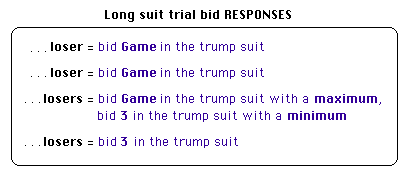(Down - Up - Top)
R-BR 24.5 - Long Suit Trial bid
The long suit trial bid :
| When a . . . . . . . suit is single raised to the . . . . level (by either Partner) the bid of . . . . . . . . . . . . is a long suit trial bid, asking Partner for his . . . . . . . . . . in the . . . . . . . . |
To make a long suit trial bid you should have . . . . . . . cards in the suit and preferably . . . but definitely at least . . . . losers.
Partner may not Pass but replies :

For Hand 3 the bidding would therefore go : 1S - 2S - You ? . . . . . . . .

Partner will reply 4S with . . . . . . . loser in . . . . . . . . even with . . . . . . points, or with . . . losers and a . . . . . .
He will reply 3S with . . . . losers and a . . . . . . or . . . . losers and . . . . . . . . . . points.
The long suit trial bid can also be made by the Responder.
Partner opened the bidding with 1C, you holding Hand 4 responded with 1S and Partner raised to 2S.
What do you do next ?

Same dilemma, Game is likely, but if Partner has . . . losers in . . . . . too the Game contract may well go down. Once again the long suit trial bid can come to the rescue.
1C - 1S - 2S - You ? . . . . . .
Whatever bid Partner makes, your contract will be more secure for it.
A long suit trial bid can also be made after . . . . . . . . . . with an . . . . . . . . . .
For example :
1S - (3D) - 2S - (Pass) - 3D
3D is still a . . . . . . . . . . . . . , to which Partner must . . . . . . . . . . . . . . . . . . . . . . .